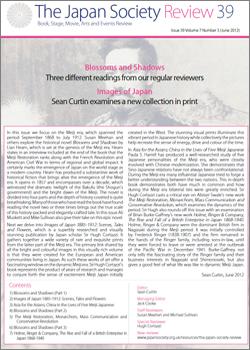Issue 39 (June 2012, Volume 7, Number 3)

In this issue we focus on the Meiji era, which spanned the period September 1868 to July 1912.
Susan Meehan and others explore the historical novel Blossoms and Shadows by Lian Hearn, which is set at the genesis of the Meiji era. Hearn states in an interview included at the end of the book that the Meiji Restoration ranks along with the French Revolution and American Civil War in terms of regional and global impact. It certainly marks the emergence of Japan on the world stage as a modern country. Hearn has produced a substantive work of historical fiction that brings alive the emergence of the Meiji era. It opens in 1857 and encompasses over a decade, which witnessed the dramatic twilight of the Bakufu (the Shogun’s government) and the bright dawn of the Meiji. The novel is divided into four parts and the depth of history covered is quite breathtaking. Many of those who have read the book have found reading the novel two or three times brings out the true scale of this history-packed and elegantly crafted tale. In this issue Ali Muskett and Mike Sullivan also give their take on this epic novel.
Next we delve into Images of Japan 1885-1912: Scenes, Tales and Flowers, which is a superbly researched and visually stunning publication by Japan scholar Sir Hugh Cortazzi. It gathers together a wide variety of rare and exquisite prints from the latter part of the Meiji era. The primary link shared by all the bright and colourful images in this visually rich volume is that they were created for the European and American communities living in Japan. As such these works of art offer a fascinating window on the dynamic Meiji era. Sir Hugh Cortazzi’s book represents the product of years of research and manages to conjure forth the sense of excitement Meiji Japan initially created in the West. The stunning visual prints illuminate this vibrant period in Japanese history while collectively the pictures help recreate the sense of energy, drive and colour of the time.
In Asia for the Asians; China in the Lives of Five Meiji Japanese Paula S. Harrell has produced a well-researched study of five Japanese personalities of the Meiji era, who were closely involved with Chinese modernization. She demonstrates that Sino-Japanese relations have not always been confrontational. During the Meiji era many influential Japanese tried to forge a better understanding between the two nations. This in-depth book demonstrates both have much in common and how during the Meiji era bilateral ties were greatly enriched.
Sir Hugh Cortazzi casts a critical eye on Alistair Swale’s new work The Meiji Restoration, Monarchism, Mass Communication and Conservative Revolution, which examines the dynamics of the period.
Sir Hugh also rounds off this issue with an examination of Brian Burke-Gaffney’s new work Holme, Ringer & Company, The Rise and Fall of a British Enterprise in Japan 1868-1940. Holme, Ringer & Company were the dominant British firm in Nagasaki during the Meiji period. It was initially controlled by Frederick Ringer (1838-1907) and the firm remained in the hands of the Ringer family, including sons-in-law, until they were forced to leave or were arrested at the outbreak of the Pacific War in December 1941. Burke-Gaffney not only tells the fascinating story of the Ringer family and their business interests in Nagasaki and Shimonoseki, but also gives a good feel of what life was like in dynamic Meiji Japan.
Contents
- Blossoms and Shadows (Part 1)
- Images of Japan 1885-1912: Scenes, Tales and Flowers
- Asia for the Asians; China in the Lives of Five Meiji Japanese
- Blossoms and Shadows (Part 2)
- The Meiji Restoration, Monarchism, Mass Communication and Conservative Revolution
- Blossoms and Shadows (Part 3)
- Holme, Ringer & Company, The Rise and Fall of a British Enterprise in Japan 1868-1940
Contributors
Editor
Sean Curtin
Managing Editor
Jack Cooke
Staff Reviewers
Susan Meehan and Michael Sullivan
Special Reviewer
Hugh Cortazzi
Reviewers
Sean Curtin and Ali Muskett

